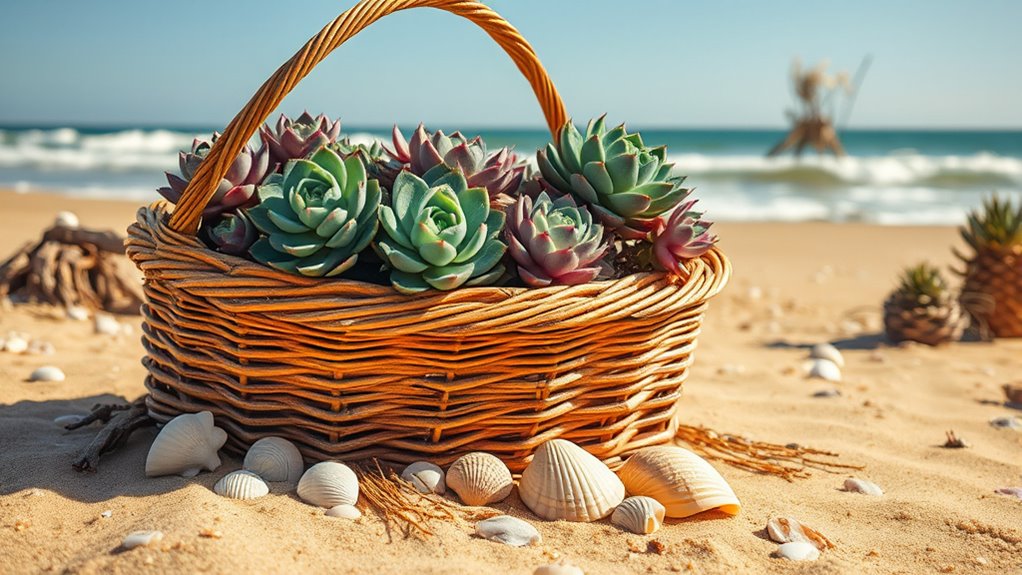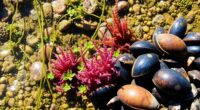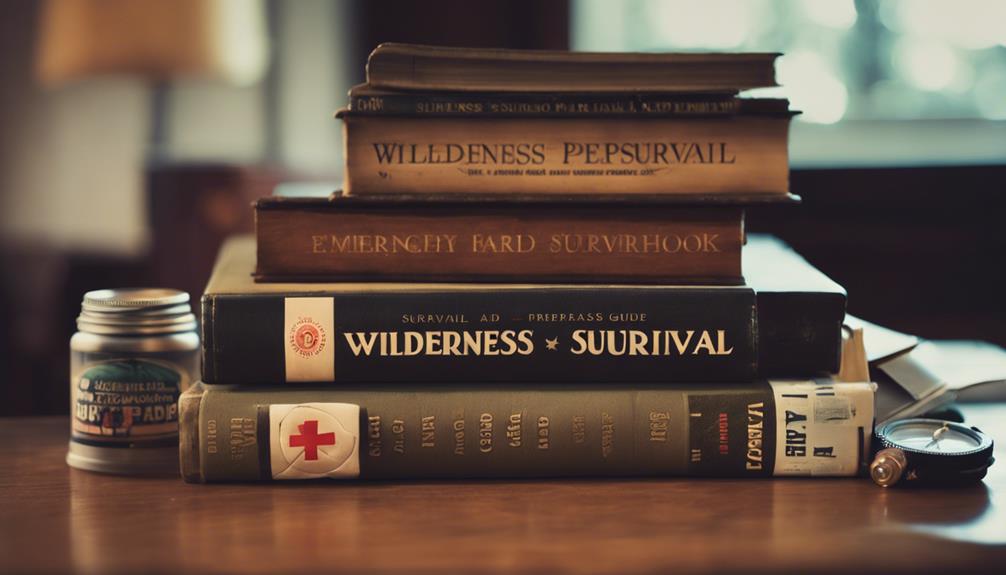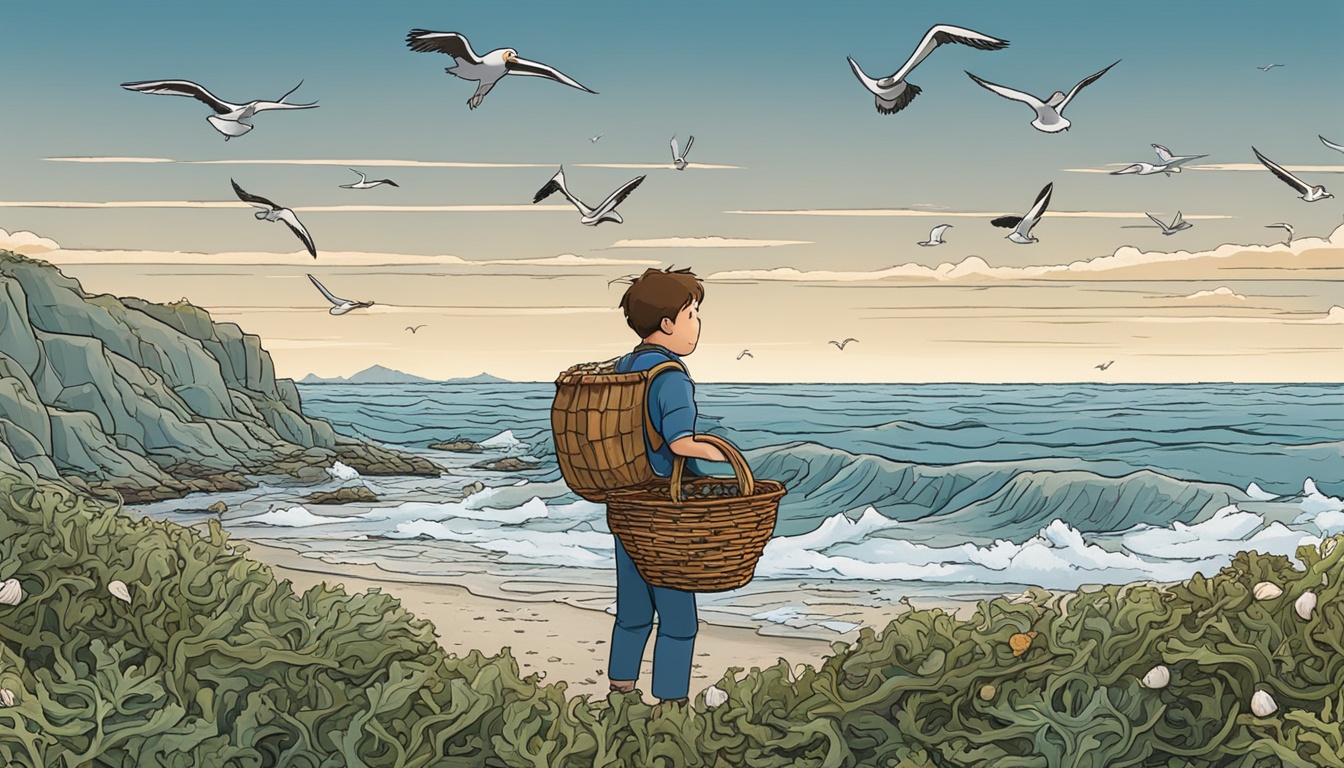Gather your beachcomber’s basket and explore the shoreline for coastal succulents like sea purslane, samphire, and salty sea lettuce. Gently rinse your finds to remove sand and grit, then incorporate these plants into fresh, crisp salads for a salty, flavorful twist. These hardy greens add crunch and umami, perfect for seaside dishes. Curious about more tips on identifying and using coastal plants? Keep going to discover how to turn these treasures into delicious, edible seaside salads.
Key Takeaways
- Use a Beachcomber’s Basket to collect colorful shells, driftwood, and sea glass for foraging coastal succulents and enhancing salads.
- Identify edible seaside plants like sea purslane, samphire, and sea lettuce by their fleshy, salt-tolerant leaves.
- Gently rinse harvested plants to remove sand and grit before incorporating them into crisp seaside salads.
- Add freshly picked coastal succulents such as samphire and sea purslane for crunch and a naturally salty flavor.
- Incorporate seaweed and herbs into salads for umami, texture, and a fresh, briny taste that captures seaside flavors.

Have you ever wondered what treasures a beachcomber’s basket might hold? When you stroll along the shoreline, it’s easy to be drawn to the colorful shells, weathered driftwood, and unexpected bits of sea glass. But if you’re interested in foraging coastal succulents for your next crisp seaside salad, your basket can become a treasure trove of edible finds. Coastal plants are often overlooked, yet many harbor flavors and textures that elevate your salads and provide a fresh, seaside twist to your meals. With a keen eye for seaside plant identification and a sense of adventure, you can gather a variety of salt tasting herbs and succulent greens that thrive in salty environments.
The first step is learning how to identify these plants safely. Many coastal succulents and herbs have distinctive features—thick, fleshy leaves that store water, and unique growth patterns that set them apart from terrestrial plants. You’ll want to familiarize yourself with common seaside plants like sea purslane, samphire, or sea lettuce. These plants often grow in salty soils or sandy dunes, and their flavor profiles range from mildly salty to intensely briny. When tasting herbs, do so cautiously—just a small nibble will reveal their saltiness without overwhelming your palate. Remember, not every plant is edible, so proper seaside plant identification is *essential* before you add anything to your basket.
As you gather, keep your basket handy for collecting these treasures. The salt tasting herbs you pick up can be rinsed gently to remove any grit or sand. Many coastal plants have a natural saltiness that can be used directly in salads or lightly seasoned to enhance their briny flavors. For example, adding freshly picked samphire to a salad introduces a crisp texture and a burst of salty flavor reminiscent of the sea. Sea purslane provides a crunchy bite and a subtle saltiness, perfect for mixing with other greens or herbs. You might also experiment with incorporating seaweed varieties, which add umami and a chewy texture that complements the succulents.
Frequently Asked Questions
Are Coastal Succulents Safe to Eat?
You might wonder if coastal succulents are safe to eat, but beware of poisonous varieties that can cause harm. Always research which succulents are edible before harvesting, and follow local harvesting regulations to protect the environment. Not all coastal succulents are safe, so proper identification is vital. When in doubt, consult an expert or reliable guide to make sure you’re foraging safely and responsibly for tasty coastal salads.
How Do I Identify Edible Coastal Succulents?
Did you know that many coastal succulents have unique features that help you identify them? To distinguish edible ones, focus on succulent identification by examining coastal plant features such as thick, fleshy leaves, and distinctive growth patterns. Avoid plants with spines, milky sap, or abnormal coloring, which often indicate toxicity. Always verify your identification with a trusted guide, and when in doubt, consult an expert before tasting.
What Tools Are Best for Foraging Succulents?
When foraging succulents, you’ll want sharp scissors or a small digging tool to guarantee precise harvesting techniques that protect the plant’s health. A sturdy knife also works well for cutting stems. Always prioritize foraging safety by carrying gloves to avoid irritation. Using the right tools helps you harvest sustainably, minimizes damage, and ensures you collect only what’s safe and edible. Remember, proper tools make all the difference in responsible foraging.
Can Coastal Succulents Be Cultivated at Home?
Imagine transforming wild coastal succulents into your own garden—can you really cultivate them at home? With proper harvesting techniques, you can start succulent cultivation even on small spaces. Coastal succulents are resilient, but they require specific conditions, like well-draining soil and plenty of sunlight. If you’re willing to mimic their natural habitat, you’ll discover that bringing these hardy plants indoors is not only possible but rewarding.
How Do I Store Foraged Coastal Succulents Safely?
To store foraged coastal succulents safely, start with proper preservation techniques like rinsing gently and drying thoroughly. Use breathable storage containers such as paper bags or mesh baskets to prevent moisture buildup. Keep the succulents in a cool, shaded place, ideally refrigerated if you plan to use them within a few days. Regularly check for spoilage, and handle them carefully to maintain freshness and ensure safe, crisp salads later.
Conclusion
As you gather these coastal treasures, remember you’re channeling the spirit of ancient foragers who thrived on nature’s bounty. With each crunchy succulent and salty leaf, you’re connecting to a timeless tradition—like a modern-day Odysseus steering the seas of flavor. So, embrace your beachcomber’s basket, and let the ocean’s gifts inspire your salads. In this dance with nature, you’re crafting more than a meal—you’re tasting the very essence of the coast’s wild, delicious soul.










